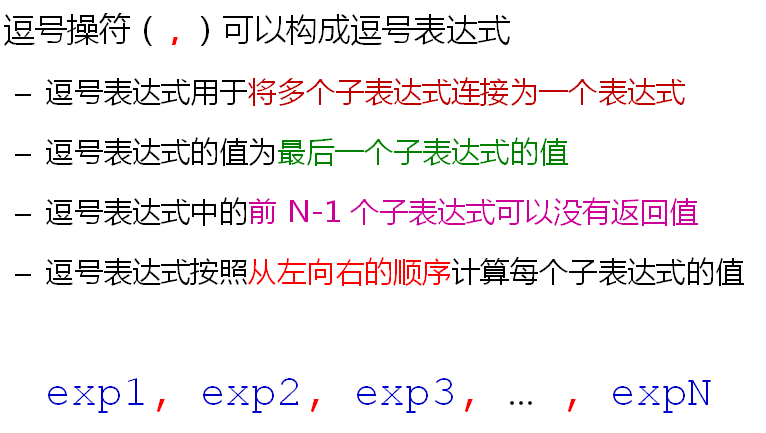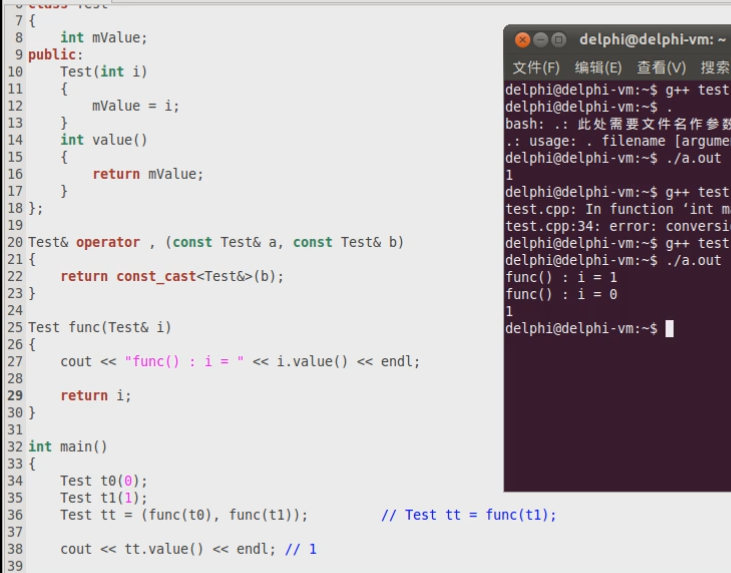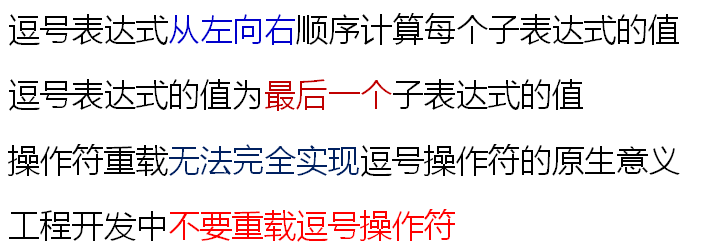逗号操作符:

我们如果重载逗号操作符,必须遵守上面的几点。特别是最后两点。
逗号操作符示例:
1 #include <iostream> 2 #include <string> 3 4 using namespace std; 5 6 void func(int i) 7 { 8 cout << "func() : i = " << i << endl; 9 } 10 11 int main() 12 { 13 int a[3][3] = { 14 (0, 1, 2), 15 (3, 4, 5), 16 (6, 7, 8) 17 }; 18 19 int i = 0; 20 int j = 0; 21 22 while( i < 5 ) 23 func(i), 24 25 i++; 26 27 for(i=0; i<3; i++) 28 { 29 for(j=0; j<3; j++) 30 { 31 cout << a[i][j] << endl; 32 } 33 } 34 35 (i, j) = 6; 36 37 cout << "i = " << i << endl; 38 cout << "j = " << j << endl; 39 40 return 0; 41 }
第35行等价于 j = 6。
重载逗号操作符:

重载逗号操作符要用全局函数。
示例程序:

我们将36行改成func调用的形式:

我们期望36行先计算func(t0),再计算func(t1),但是从输出结果可以看出,先计算的是func(t1)。这违背了逗号表达式的原生语义。
问题的本质分析:

我们将重载的逗号操作符注释掉,再次演示:
1 #include <iostream> 2 #include <string> 3 4 using namespace std; 5 6 class Test 7 { 8 int mValue; 9 public: 10 Test(int i) 11 { 12 mValue = i; 13 } 14 int value() 15 { 16 return mValue; 17 } 18 }; 19 /* 20 Test& operator , (const Test& a, const Test& b) 21 { 22 return const_cast<Test&>(b); 23 } 24 */ 25 Test func(Test& i) 26 { 27 cout << "func() : i = " << i.value() << endl; 28 29 return i; 30 } 31 32 int main() 33 { 34 Test t0(0); 35 Test t1(1); 36 Test tt = (func(t0), func(t1)); // Test tt = func(t1); 37 38 cout << tt.value() << endl; // 1 39 40 return 0; 41 }
输出结果如下:

这意味着第36行的逗号表达式严格的从左向右执行了。而且返回了最后一个表达式的值。
工程中不要重载逗号操作符。
小结:
